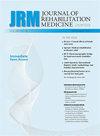Efficacy of selective neurotomy for focal lower limb spasticity: a systematic review.
IF 2.5
4区 医学
Q1 REHABILITATION
引用次数: 0
Abstract
OBJECTIVE Selective neurotomy has been suggested as a permanent treatment for focal spasticity. A systematic literature review was performed to investigate the efficacy of selective neurotomy regarding focal lower limb spasticity. METHODS A systematic search in PubMed, Medline, Cochrane, and Embase databases was carried out. Studies were included if they reported on the following outcomes: muscle tone, muscle strength, pain, ankle range of motion and/or walking speed, after selective lower limb neurotomy in any type of upper motor neuron syndrome. RESULTS A total of 25 non-randomized and/or uncontrolled studies and 1 randomized controlled study were selected. The included studies reported improvements in terms of leg muscle tone, pain, passive range of ankle motion, and walking speed. CONCLUSION The results suggest that selective neurotomy is effective for reducing lower limb spasticity, without any negative effects on walking speed. However, this conclusion is primarily based on uncontrolled case series, whereas conclusions on clinical efficacy should preferably be based on comparison with a reference treatment through (randomized) controlled trials. Future studies should also include quantitative, validated functional assessment tools to further establish the efficacy of selective neurotomy as long-lasting treatment for patients with focal lower limb spasticity.选择性神经切除术治疗局灶性下肢痉挛的疗效:系统性综述。
目的选择性神经切除术被认为是局灶性痉挛的一种永久性治疗方法。方法在 PubMed、Medline、Cochrane 和 Embase 数据库中进行了系统性检索。结果共筛选出 25 项非随机和/或非对照研究以及 1 项随机对照研究。结果表明,选择性神经切除术能有效减轻下肢痉挛,且不会对行走速度产生任何负面影响。然而,这一结论主要是基于非对照的病例系列,而临床疗效的结论最好是通过(随机)对照试验与参考治疗进行比较后得出的。未来的研究还应包括定量、有效的功能评估工具,以进一步确定选择性神经切除术作为局灶性下肢痉挛患者的长期治疗方法的疗效。
本文章由计算机程序翻译,如有差异,请以英文原文为准。
求助全文
约1分钟内获得全文
求助全文
来源期刊
CiteScore
5.60
自引率
5.70%
发文量
102
审稿时长
4-8 weeks
期刊介绍:
Journal of Rehabilitation Medicine is an international peer-review journal published in English, with at least 10 issues published per year.
Original articles, reviews, case reports, short communications, special reports and letters to the editor are published, as also are editorials and book reviews. The journal strives to provide its readers with a variety of topics, including: functional assessment and intervention studies, clinical studies in various patient groups, methodology in physical and rehabilitation medicine, epidemiological studies on disabling conditions and reports on vocational and sociomedical aspects of rehabilitation.

 求助内容:
求助内容: 应助结果提醒方式:
应助结果提醒方式:


